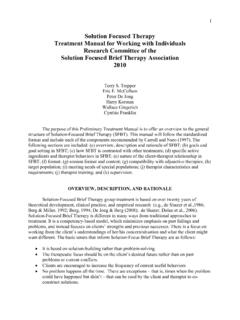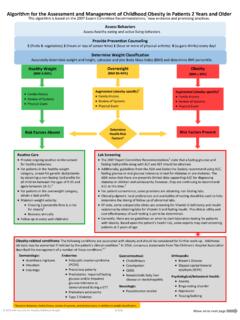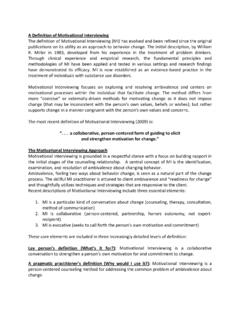Transcription of Motivational Interviewing: A process of empathy and self ...
1 Motivational interviewing - A conversation of empathy and Self-healing Motivational interviewing (MI) is a patient-centered counseling approach used during a clinical visit. It can be briefly integrated into patient encounters and is designed to promote clarity and open communication while enhancing motivation to change behavior and clarify decisions among patients who are confused and not ready to change . MI is not just a series of techniques, but a spirit of collaboration and evoking of personal resources, while respecting the autonomy and personal freedom of choice. Based on five principles, MI can assist patients in behavior change and enhance their resolve and personal-motivation. By focusing on the patient s concerns, perspectives and individual experience, as well as emphasizing personal choice in their healing process , MI offers strategies on a continuum.
2 This may range from awareness of there not being a problem, to total commitment to utilize the steps in solving complex ones that are truly there. Techniques such as reflective listening, summarizing a conversation, and weighing costs and benefits, are utilized in MI, as communication styles supporting the patient s hopes, optimism, and self-efficacy. The five principles of Motivational interviewing are: (1) The practitioner uses empathy to engage, (2) develops discrepancy between where the patient is health wise and where they want to be, (3) avoids argumentation, while rolling with resistance , (4) restrains the patient from taking a counter position to what you have said which would advantage their own status quo, and (5) supports the patient s belief in themselves being able to build self efficacy. This is an interviewing conversation rather than expert-directed and elicits careful questioning and listening on both sides.
3 Information is shared reciprocally and is non-judgmental. A supportive, patient-centered atmosphere is pivotal to MI, where patients feel comfortable enough to explore their own reality and conflicts. Outlining a patient s goals (where they want to be) and their present situation (where they are) is an important part of developing the divergence from sickness to healing behavior. Keeping the tone Motivational versus argumentative is a fundamental principle of MI and meets a patient s resistances with a different approach; 1instead of confrontation or opposition, the practitioner keeps the conversation open, positive and on course. Instilling the belief that change is the choice of the patient rather than the practitioner centers the locus of control within the patient, rather than in an authoritarian way with the practitioner. PATIENT/PROVIDER COMMUNICATION Listening In MI, listening involves checking out the perspective and ideas of the child and family.
4 This makes MI a family-focused process . The provider replaces traditional interviewing that often placed the provider in the authority role. The MI goal is to refrain from communication styles of teaching that may diminish the child s/family s authority and voice. An example can be observed with Sarah, a pre-teen who had been diagnosed as having ADHD since 5 years of age and had recently not been taking her medication consistently. Associated with her resistance to medication had been an associated slipping of her grades with a possible school failure outcome ahead. Hope in re-establishing her treatment adherence and the recovery of her borderline academic achievement appeared to be contingent on engaging and talking to Sarah in an open conversation. Gaining her opinion on the one hand, while listening to her express her beliefs and getting her to assert her preferences and goals on the other hand, was essential to such a conversation.
5 Prematurely lecturing and educating Sarah about the consequences of school failure only using school to hang out with friends, shirking viable problem solving, and finding good solutions, would only deepen her resistance, possibly engage increased guilt, self-blame, and quickly close the door to further conversation about the usefulness of medication and possibly weaken the relationship. Research suggests that that 80% of the population often doesn t think there is a problem or are conflicted by their own ambivalence and contradictory behaviors while engaging in a contemplative pros and cons way. Likely, less than 20% of people at any one time might be willing to engage in change talk and be willing to consider a plan or even show readiness to be 2educated with the necessary insights. Education strategies can have a reverse effect if done too early.
6 By reducing motivation for change , rather than increasing the chances, people who are ambivalent can take a self-righting stance . This means that where in the past they may have just argued, opposed the provider s position, and offered reasons not to change , the provider provides conversations assisting people in not talking themselves out of the change process prematurely. The Language of change Talk The intention of MI is to move toward ways of change talk (eliciting the reasons for change ). In this way the provider attempted to gain Sarah as a partner in the change process and create a conversation in which Sarah could come up with her own ideas and argue for reasons why she might benefit from resuming medication adherence. Note: The more that patient s hear themselves verbally defend their own position, the more committed they become to take steps leading to action.
7 The question was how to get Sarah to use more change talk? First, the provider waited for Sarah to hear herself and in this the provider had to be good listener themselves. By using the following kinds of talk in normal conversation Sarah was more able to recognize the patterns better by the feedback she gained. By listening to what she said, one could tell how Sarah reconsidered medication. If the provider had argued for medication and gotten into an argument with her, Sarah would have countered with a defense of keeping things the same. Sarah would have won the fight temporarily and such a normal resistance had to be considered. The use of the following conversational cues may help in avoiding such dead end verbal interactions. Desired are alternative responses of I will take or I will or I will consider it, or I might.
8 To obtain such verbal responses it will be helpful to learn the six possible ready-able and willing themes using the DARN-CASA mnemonic: D esire statements: Using I wish, I want to, or I would like are examples of preferences. Why might you want to do this? A bility statements: Sound out strengths of one s position with can and could. What is possible for you? If you decided to take your medication, how would you do it? 3 R eason statements: May be added after language of ability connected with because. For example, ..so my grades would improve and get people off my back. What are some benefits? (Why?) statements. N eeds: Needs verbs construe significance and importance. I should get organized or get my work turned in. Use must and have to. How important is it to make this change ? C ommitment words include words that connote readiness with I am going to, I will, and I intend to.
9 S teps toward action: This promotes further along the change continuum and does something that moves Sarah in the direction of making it happen. Make a plan and now is the time for problem solving. A mbivalence: Weighing pros and cons and starts out resolving the barriers to free choice and making a decision is a major feature of Motivational interviewing as a way to manage ambivalence around change . Early conflicts about pros and cons for each side of one s dilemma often lead to keeping bad habits and routines the same. Such is often the case for keeping things the same in one s lifestyle and unhealthy behaviors. Sarah expressed costs and benefits related to stopping her medication. Asking her, What is good about the way things are now? may signal: I don t have to go to the office to take a pill, There is less hassle, and I have fewer headaches.
10 On the other hand, The teachers are on my case, and Parents are disapproving of my behavior and report card, and I don t like the idea of a pill controlling me. A key strategy is to provide a summary at the end of these junctures to highlight both sides of the dilemma, how one horn undermines the goals of the other. For example, What do you make of this? or Where do you go from here? After an empathic statement, do not prematurely start problem solving if the patient is still arguing and resisting you. Rather, What would the first step be for you? By going through this, Sarah is more likely to 4carry out a plan if she can answer what, where, when, and how, she will do it. If Sarah is not really ready, it will be not as threatening going back a step using conjecture and indefinite language such as What might it take to make a decision for you?





